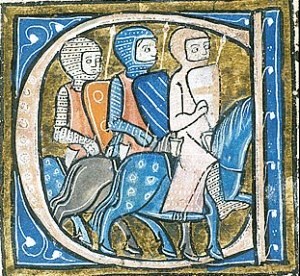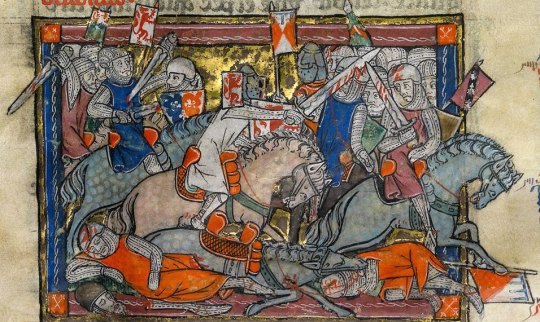(Continued from part 1)
 Despite the fact they resided at the top of the feudal pyramid, medieval noblemen were not all created equally.
Despite the fact they resided at the top of the feudal pyramid, medieval noblemen were not all created equally.
Rather, noblemen were subdivided based on whether they were lords, heirs, or younger sons.
Younger sons
Younger sons – sometimes referred to as “spares” since mortality in the Middle Ages was such that a spare could become an heir virtual overnight – where the most disadvantaged of medieval men of birth.
Under the system of primogeniture, it was the firstborn son who inherited the father’s lands and titles.
Sometimes, this inheritance comprised only the property the father had inherited from his father, leaving additional lands obtained through conquest, purchase, or reward to be disposed of at will amongst younger sons. But this wasn’t always the case.
As a result, younger sons were often forced to make their own way in the world with little to no help from their families. This might have seen them pursuing one or more of the following paths:
- Entering the church (regardless of whether they possessed a true spiritual calling)
- Attempting to win land through meritorious service to an overlord
- Journeying abroad to become a merchant, to fight in the Holy Land, or become a routier (a mercenary)
Frances and Joseph Gies, authors of Marriage and the Family in the Middle Ages, confirm about younger sons that,
Most expended their green manhood “in tourneys and in war”, in expeditions and Crusades, in hunting, carousing, and lechery, and died at a young age. (p. 144)
The best way a younger son managed to avoid such a grim fate was by marrying an heiress.
Whether a widow in possession of her dower (her entitled portion of her late husband’s lands) or a well-dowried maiden, an heiress brought a younger son all the wealth and social standing he’d likely never acquire otherwise. Indeed, without marriage, most younger sons remained landless bachelors for life.
Heirs
Heirs were the lucky winners of the medieval numbers game. By no greater merit than having been born first, they were due to inherit all their fathers’ assets and thus be more or less set for life.
As such, an heir’s biggest concern was to not die before he had the chance to succeed to his inheritance, something that often proved challenging, both due to the prevalence of sickness disease in the Middle Ages and the lifestyle of men in general.
According to the Gies,
Except those who went into the Church, all young noblemen, heirs as well as cadets, underwent a period of vagabondage, often with a mentor chosen to initiate them into the game of knight-errantry – war, tournament, adventure. Travelling in bands of companions, the young knights led a life in which pleasure mingled with violence, death was commonplace, and turbulence reigned. (p. 143)
 The Gies go on quote historian Kenneth McFarlane, stating,
The Gies go on quote historian Kenneth McFarlane, stating,
“It is not generally realized … how near to extinction most [noble] families were; their survival was always in the balance and only a tiny handful managed to hang on in the male line from one century to another.” (p. 186)
The death of an heir was a disastrous occurrence for a noble family. If no other sons or male relatives existed in the family, the eventual death of the lord left no one to inherit but a female child. Since women couldn’t hold land in their own right, land and assets would become the property of a daughter’s husband.
In the case of multiple daughters, no real advantage existed in being born first, as the land would be divided equally to provide a dowry for all of them. The land would forever be removed from the male side of the family, resulting in what was known as a failed male line.
Lords
Finally, there were noble lords, who sat on top of the feudal world.
Of course, there were notable differences in the power and prestige wielded by noblemen in accordance to their rank – a baron sat above a knight, an earl above a baron, and the king above them all – however every lord was the veritable king of his own immediate sphere.
Another similarity between varying ranks of noblemen, regardless of their possessions and enviable social position, is that they were perennially cash-poor, forever in debt to moneylenders or the king or both.
In part because of this perpetual insolvency and in part because every lord desired ever greater influence and independence in his position, nobleman would often cultivate multiple allegiances. That is to say, they would come to hold land of more than one lord, which would increase the sum of their land holdings.

However, it would also often create situations involving conflicting oaths of homage and obligations to serve – something that undermined the feudal system’s ideological foundation of a vassal’s sworn loyalty to a single lord. Records exist of the tortuous (and often profitable) arrangements vassals would make to serve two lords simultaneously, particularly if the two came into conflict with each other.
According to the Gies in Life in a Medieval Castle,
The most powerful barons, holders of castles and fief from a number of lords, were the strong men of the thirteenth century, able to resist kings and emperors. (p. 54).
It was to this level that most nobleman, even those who came nowhere close to it, secretly aspired. One trait of noblemen that was in no way a secret, though, was their relentless regard for their own affairs above all else. Again from Life in a Medieval Castle:
If the sovereign demands grew excessive, or if self-interest dictated, the baron seldom hesitated to take up arms in rebellion, his feudal oath notwithstanding. He sat on the king’s council … partly to help the king make decisions, but mainly to look out for his own interests. (p. 40)
Read all Medieval Mondays posts
(Image source #1, #2, and #3)

You’re reminding me so much of two of my favorite classes in university, Late Antiquity and The Middle Ages. Thank you for the refresher!
LikeLike
These are my favourite historical eras as well. 🙂
LikeLiked by 1 person
Thank you Janna for this exposition, both comprehensive and understandable.
LikeLike
Thanks, Roy. Now I just need to master comprehensive and understandable (yet not overwhelming) exposition in my actual novel. 🙂
LikeLiked by 1 person